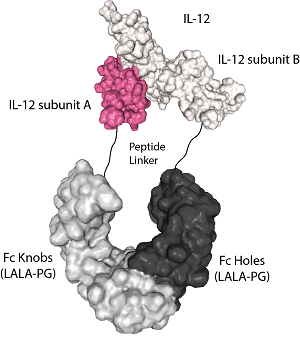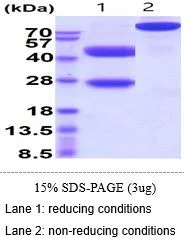IL-12 (mouse):Fc-KIH (human) (rec.)
AG-40B-0240
Protein IDP43431
Product group Proteins / Signaling Molecules
Overview
- SupplierAdipoGen Life Sciences
- Product NameIL-12 (mouse):Fc-KIH (human) (rec.)
- Delivery Days Customer10
- CertificationResearch Use Only
- Concentration1 mg/ml
- Estimated Purity>95%
- Protein IDP43431
- Protein NameInterleukin-12 subunit alpha
- Scientific DescriptionInterleukin-12 (IL-12) family members are heterodimer glycoproteins, composed of two covalently linked subunits, alpha and beta chains. The alpha-subunit consists of IL-23p19, IL-27p28 and IL-12p35, and the beta-subunit includes IL-12p40 and Epstein-Barr virus-induced gene (Ebi3). IL-12 members bind to cognate heterodimeric receptor chains expressed on T cells. This family includes IL-12, IL-23, IL-27, IL-35 and IL-39. IL-12 and IL-23 are predominantly proinflammatory cytokines that contribute key roles in the development of Th1 and Th17 cells, respectively. IL-27 has both pro- and anti-inflammatory properties and is a potent T cell immunomodulator. IL-35, a new member of this family, is a potent inhibitory cytokine produced by natural, thymus-derived regulatory T cell (nTreg) populations. IL-39, the newest member of IL-12 family, mediates the inflammatory response through the activation of STAT1/STAT3 signaling pathway. These IL-12 family members link innate immunity with the development of adaptive immunity and are also important for regulating T cell responses. IL-12 is composed of two subunits IL-12A/p35 and IL-12B/p40 and signals via a high-affinity IL-12R, leading to activation of STAT 4. IL-12 is produced by macrophages, dendritic cells and B cells. The key role of the pro-inflammatory IL-12 is to induce the IFN-gamma which regulates the Th responses, to promote the naive T cells to directly differentiate into effector cells (Th1) and then release IFN-gamma. The protein IL-12 (mouse):Fc-KIH (human) (rec.) is produced by using two different vectors, one encoding for the IL-12A/p35:Fc Knobs sequence (synthesizing a protein of 60kDa) and one encoding for the IL12B/p40:Fc Holes sequence (synthesizing a protein of 75kDa). Both vectors transfected into CHO cells produce both Fc molecules (Knobs-into-Holes technology; J.B. Ridgway, et al.; Protein Eng. 9, 617 (1996)) required for dimerization and for secretion of the final protein IL-12 (mouse):Fc-KIH (human) (rec.). InVivoKines™ are a new generation of recombinant fusion proteins for immunotherapeutic, preclinical and translational in vivo research, developed and manufactured by AdipoGen Life Sciences. - InVivoKines™. Recombinant protein. IL-12A/p35 (aa 23-215) (mouse):Fc Knobs and IL-12B/p40 (aa 23-335) (mouse):Fc Holes form the IL-12 (mouse):Fc-KIH (human) using the Knobs-into-Holes technology (see reference: J.B. Ridgway, et al.; Protein Eng. 9, 617 (1996)). Source: CHO cells. Lyophilized. Contains PBS Interleukin-12 (IL-12) family members are heterodimer glycoproteins, composed of two covalently linked subunits, alpha and beta chains. The alpha-subunit consists of IL-23p19, IL-27p28 and IL-12p35, and the beta-subunit includes IL-12p40 and Epstein-Barr virus-induced gene (Ebi3). IL-12 members bind to cognate heterodimeric receptor chains expressed on T cells. This family includes IL-12, IL-23, IL-27, IL-35 and IL-39. IL-12 and IL-23 are predominantly proinflammatory cytokines that contribute key roles in the development of Th1 and Th17 cells, respectively. IL-27 has both pro- and anti-inflammatory properties and is a potent T cell immunomodulator. IL-35, a new member of this family, is a potent inhibitory cytokine produced by natural, thymus-derived regulatory T cell (nTreg) populations. IL-39, the newest member of IL-12 family, mediates the inflammatory response through the activation of STAT1/STAT3 signaling pathway. These IL-12 family members link innate immunity with the development of adaptive immunity and are also important for regulating T cell responses. IL-12 is composed of two subunits IL-12A/p35 and IL-12B/p40 and signals via a high-affinity IL-12R, leading to activation of STAT 4. IL-12 is produced by macrophages, dendritic cells and B cells. The key role of the pro-inflammatory IL-12 is to induce the IFN-gamma which regulates the Th responses, to promote the naive T cells to directly differentiate into effector cells (Th1) and then release IFN-gamma. The protein IL-12 (mouse):Fc-KIH (human) (rec.) is produced by using two different vectors, one encoding for the IL-12A/p35:Fc Knobs sequence (synthesizing a protein of 60kDa) and one encoding for the IL12B/p40:Fc Holes sequence (synthesizing a protein of 75kDa). Both vectors transfected into CHO cells produce both Fc molecules (Knobs-into-Holes technology; J.B. Ridgway, et al.; Protein Eng. 9, 617 (1996)) required for dimerization and for secretion of the final protein IL-12 (mouse):Fc-KIH (human) (rec.).
- Storage Instruction-20°C,2°C to 8°C
- UNSPSC12352202



